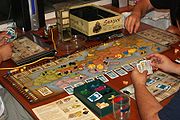.gif)
Shogun (board game)
Encyclopedia
Shogun is a strategy board game designed by Dirk Henn
and published by Queen Games
in 2006. It is based on his earlier game Wallenstein (board game)
, but it is set in the Sengoku period
, which ends with the inception of the Tokugawa Shogunate
.
 The main game board is printed on both sides, one being printed with a sun symbol and the other with a moon symbol. Each side displays 5 regions. These 5 regions each contain 9 internal provinces. These configurations differ on either side of the board.
The main game board is printed on both sides, one being printed with a sun symbol and the other with a moon symbol. Each side displays 5 regions. These 5 regions each contain 9 internal provinces. These configurations differ on either side of the board.
Dirk Henn
Dirk Henn is a German-style board game designer who was born in Bendorf, GermanyDirk Henn is best known for his game Alhambra, which won the Spiel des Jahres and placed 2nd in the Deutscher Spiele Preis in 2003....
and published by Queen Games
Queen Games
Queen Games is a German publisher of tabletop games, based in Troisdorf and founded in 1992 by head Rajive Gupta, which specialises primarily in German-style, family-level games but has also published smaller numbers of both simpler, children's games and more complex, gamers' games.They have shown...
in 2006. It is based on his earlier game Wallenstein (board game)
Wallenstein (board game)
Wallenstein is a medium-weight German-style board game designed by Dirk Henn and published by Queen Games in 2002. Though set during the Thirty Years' War, Wallenstein should not be confused with a complex wargame. Rather, it has the feel of a light strategy game with the familiar Euro elements...
, but it is set in the Sengoku period
Sengoku period
The or Warring States period in Japanese history was a time of social upheaval, political intrigue, and nearly constant military conflict that lasted roughly from the middle of the 15th century to the beginning of the 17th century. The name "Sengoku" was adopted by Japanese historians in reference...
, which ends with the inception of the Tokugawa Shogunate
Tokugawa shogunate
The Tokugawa shogunate, also known as the and the , was a feudal regime of Japan established by Tokugawa Ieyasu and ruled by the shoguns of the Tokugawa family. This period is known as the Edo period and gets its name from the capital city, Edo, which is now called Tokyo, after the name was...
.
Background
Japan during the Sengoku or “Warring States” Period: each player assumes the role of a great Daimyo with all his troops. Each Daimyo has the same 10 possible actions to develop his kingdom and secure points. To do so he must deploy his armies with great skill. Each round, the players decide which of the actions are to be played out and in which of their provinces. If battle ensues between opposing armies, the unique Cubetower plays the leading role. The troops from both sides are thrown in together and the cubes that fall out at the bottom show who has won immediately. Owning provinces, temples, theaters and castles means points when scores are tallied. Whichever Daimyo has the highest number of points after the second tally becomes shogun and wins the game.Main Game Board

Cards
Shogun contains 6 different types of cards:- Province Cards: For each province on the main game board there is a corresponding province card. If the province is shown on both sides, there will be two province cards; One with a sun symbol and one with a moon symbol indicating which side of the game board it corresponds to.
- War Chest Cards: Displaying war chests with values (0-4).
- Special Cards: This card grants the owner a unique ability. Every Player receives one and only one.
- Action Cards: Determine the order in which game events take place.
- Event Cards: Display random events that affect all players.
- Daimyo Cards: Used to show player turn order.
Others
- Cubes: Shogun uses colored Cubes to represent armies. There are 310 Cubes in 5 colors (Black, Red, Yellow, Purple and Blue), so that each color has 62 Cubes. There are also plus 20 Green Cubes to represent neutral farmer armies.
- War Chests: 35 wood-colored chest with a value of 1, and 20 orange-colored chests with a value of 5.
- Building Tiles: 28 castles, 26 temples, and 26 Theatres. Players may build these buildings in their provinces to earn victory points.
- Battle Tower: Used to conduct battles. Both the attacking and defending player resolve the battle by throwing their Cubes in Battle Tower.
External links
- Shogun webpage at Queen Games

